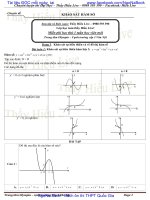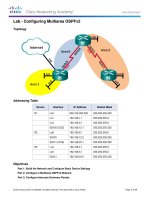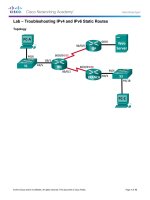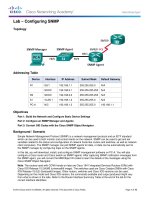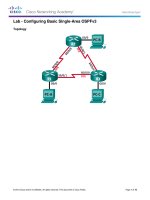Ch8 learning kho tài liệu bách khoa
Bạn đang xem bản rút gọn của tài liệu. Xem và tải ngay bản đầy đủ của tài liệu tại đây (1.95 MB, 42 trang )
Learning from
Observations
5/3/2013
1
Outline
• Learning agents
• Inductive learning
• Decision tree learning
5/3/2013
2
Learning?
"Learning is
making useful changes
in our minds."
Marvin Minsky
5/3/2013
3
Learning?
"Learning is
constructing or
modifying
representations
of what is being
experienced."
Ryszard Michalski
5/3/2013
4
Learning?
"Learning denotes
changes
in a system that ...
enable a system to do
the same task
more efficiently the next
time."
1916 - 2001
5/3/2013
Herbert Simon
5
Learning
• Learning is essential for unknown environments,
– i.e., when designer lacks omniscience
• Learning is useful as a system construction method,
– i.e., expose the agent to reality rather than trying to write
it down
• Learning modifies the agent's decision mechanisms
to improve performance
5/3/2013
6
Why do machine learning?
• Understand and improve efficiency of human learning
– use to improve methods for teaching and tutoring people, as
done in CAI -- Computer-aided instruction
• Discover new things or structure that is unknown to
humans
– Data mining
• Fill in skeletal or incomplete specifications about a
domain
– Large, complex AI systems cannot be completely derived by
hand and require dynamic updating to incorporate new
information.
– Learning new characteristics expands the domain or expertise
and lessens the "brittleness" of the system
5/3/2013
7
Components of a Old Agent
Agent
Environment
Sensors
Model of World
(being updated)
Prior Knowledge
about the World
Reasoning &
Decisions Making
Effectors
5/3/2013
List of
Possible Actions
Goals/Utility
8
Learning agents
5/3/2013
9
Components of a Learning Agent
Environment
Sensors
Performance
Element
Effectors
5/3/2013
10
Components of a Learning Agent
LE changes PE based on how it is doing
PE provides knowledge to LE
Environment
Sensors
Performance
Element
Learning
Element
Effectors
5/3/2013
11
Components of a Learning Agent
C provides feedback to LE on how PE is doing
C compares PE with a standard of
performance that’s told (via sensors)
Environment
Sensors
Critic
Performance
Element
Learning
Element
Effectors
5/3/2013
12
Components of a Learning Agent
PG suggests problems or actions to PE that
will generate new examples or experiences
that will aid in achieving the goals from the LE
Environment
Learning Agent
Sensors
Critic
Performance
Element
Effectors
5/3/2013
Learning
Element
Problem
Generator
13
Components of a Learning Agent
Environment
Learning Agent
Sensors
Critic
Performance
Element
Effectors
5/3/2013
Learning
Element
Problem
Generator
14
Learning element
• Design of a learning element is affected by
– Which components of the performance element are to be
learned
– What feedback is available to learn these components
– What representation is used for the components
• Type of feedback:
– Supervised learning: correct answers for each example
– Unsupervised learning: correct answers not given
– Reinforcement learning: occasional rewards
5/3/2013
15
Inductive learning
• Simplest form: learn a function from examples
• Extrapolates from a given set of examples so that
accurate predictions can be made about future
examples.
• f is the target function
– An example is a pair (x, f(x))
– Problem: find a hypothesis h
• such that h ≈ f
• given a training set of examples
5/3/2013
16
Supervised vs. Unsupervised learning
• Supervised:
– "teacher" gives a set of both the input examples and
desired outputs, i.e. (x, f(x)) pairs
• unsupervised:
– only given the input examples, i.e. the x
• In either case, the goal is to determine an
hypothesis h that estimates f.
5/3/2013
17
Inductive learning method
• Construct/adjust h to agree with f on training set (h
is consistent if it agrees with f on all examples)
• E.g., curve fitting:
5/3/2013
18
Inductive learning method
• Construct/adjust h to agree with f on training set (h
is consistent if it agrees with f on all examples)
• E.g., curve fitting:
5/3/2013
19
Inductive learning method
• Construct/adjust h to agree with f on training set (h
is consistent if it agrees with f on all examples)
• E.g., curve fitting:
5/3/2013
20
Inductive learning method
• Construct/adjust h to agree with f on training set (h
is consistent if it agrees with f on all examples)
• E.g., curve fitting:
5/3/2013
21
Inductive learning method
• Construct/adjust h to agree with f on training set (h
is consistent if it agrees with f on all examples)
• E.g., curve fitting:
5/3/2013
22
Inductive learning method
• Construct/adjust h to agree with f on training set (h
is consistent if it agrees with f on all examples)
• E.g., curve fitting:
• Ockham’s razor: prefer the simplest hypothesis
consistent with data
5/3/2013
23
Learning decision tree
5/3/2013
24
Learning decision trees
• Problem: decide whether to wait for a table at a
restaurant, based on the following attributes:
–
–
–
–
–
–
–
–
–
–
5/3/2013
Alternate: is there an alternative restaurant nearby?
Bar: is there a comfortable bar area to wait in?
Fri/Sat: is today Friday or Saturday?
Hungry: are we hungry?
Patrons: number of people in the restaurant (None, Some, Full)
Price: price range ($, $$, $$$)
Raining: is it raining outside?
Reservation: have we made a reservation?
Type: kind of restaurant (French, Italian, Thai, Burger)
WaitEstimate: estimated waiting time (0-10, 10-30, 30-60, >60)
25


